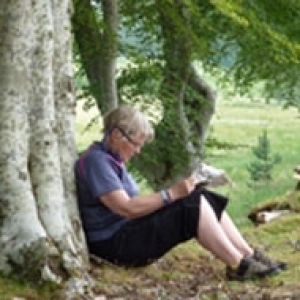Standing Stones and All That Jazz
His Lordship and I have been time travellers today; we have travelled back 5,000 years and have seen more standing stones and neolithic treasures than a couple who have seen a lot of standing stones and neolithic treasures.
We took a stagecoach tour of the Orkney mainland to visit Scapa Flow, Skara Brae, the ring of Brodgar and the standing stones of Stenness.
Scapa Flow is a natural deep water channel which a German Submarine entered from the North Sea in 1939 at the beginning of WW2 and torpedoed the British Warship Royal Oak, at anchor there. The latter sank in 15 minutes with the loss of 800 men and boys. It remains up ended in the bay and is now a recognised war grave.
To prevent anything like this happening again, Churchill ordered the building of the 4 concrete Churchill barriers linking the islands of Lambholm, Glimpsholm, and Burray with South Ronaldsay, thereby blocking the passage from the North sea to Scapa. Nowadays there are causeways over the barriers and the roads are busy highways linking the mainland of Orkney with the south, and ferries to the Scottish Mainland
I have visited Skara Brae before about 25 years ago, on a day when the wind howled off the beach stinging my face with sand abrasive force, leaving me wondering how much harder life could be for this neolithic settlement on a beach in the back of beyond.
But today, there was no wind and the sun shone on the white sand of the beach there and glittered on a sea of impossible blueness : an altogether better setting for viewing the settlement.
The thick stone walls and turf roofs of the houses, with the fire in the centre of the room and the beds arranged round the walls would have kept the occupants quite snug.
The most remakable thing to see was the stone dresser at one end where people would keep their valuable posessions. It was a small touch which made it almost possible to connect with our ancestors.
Then on to the Ring of Brodgar, a ring of standing stones, of which only 30 of the original 60 are left. It was constructed about 2.500 years ago, and could have been a place of worship or for ceremonial occasions. Because it is surrounded by a ditch it is a 'henge' like the more famous one at Stonehenge.
It stands between Lochs Harray and Stenness- Harray being freshwater and Stenness being salt water. ( I do hope I've got that the correct way round)
Fairly near the Ring of Brodgar is another smaller circle of taller stones, the Standing Stones of Stenness, most of them now gone.
The bus took us down to the Italian Chapel, but since we had cycled there yesterday, we escaped the tour to sample some Orkney ice cream at the small wooden wine centre at the foot of the driveway.
It did seem to be an odd place to have a wine outlet, but perhaps the Italian influence is paramount in the area.
So all in all a lot of boxes ticked in a short time, and best of all, with our Scottish bus passes, it was FREE
There's a saying, 'You can take a lady out of Scotland but you can't take Scotland out of a lady. Free is Good!
Rather a dry blog, I'm afraid- apologies.
The blip if you get this far is of some stones in the Ring of Brodgar.

Comments
Sign in or get an account to comment.


